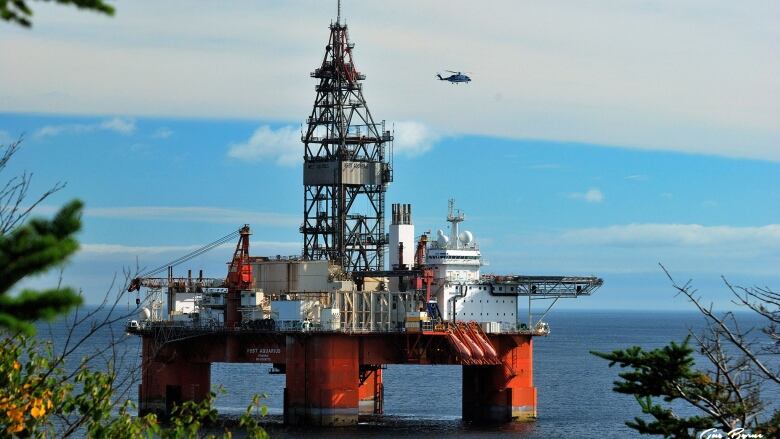Mi'kmaq want answers from BP Canada after drilling mud spill off Nova Scotia coast
Environmental impacts still unclear as investigation into incident begins

Mi'kmaqchiefs from Nova Scotia and New Brunswick are voicing concerns after a mechanical failure on a BPCanada drilling rig resulted in 136,000 litres of synthetic-based "drilling mud" being spilled into waters off the coast of Nova Scotia.
The incident, reported Friday by the Canada-Nova Scotia Offshore Petroleum Board (CNSOPB), came 65 days after drilling began on the Scotia Basin exploratory well project, 330 kilometres from Halifax.
A spokesperson for the CNSOPB confirmed Monday that drilling has halted, but because an investigation into the spill is ongoing, declined an interview. They said more information would be released to the public this week.
In a statement releasedSaturday, the Assembly of Nova Scotia Mi'kmaq Chiefs sought clarification on what went wrong, and if BP can ensure that it doesn't happen again.
"We want answers from BP Canada," said Chief Terrance Paul, who holds the Assembly's fisheries portfolio.

"We want to know how this could happen, what effect it could potentially have on our fisheries and what they are going to do to address that. Incidents like this are unacceptable in Mi'kma'ki."
The Assembly said the incident raises questions about the safetyof the lands and waters, as well as any wildlife in the potentially affectedarea.
'We regret it happened'
Anita Perry, regional manager of BP Canada said the company "deeply regrets" the spill, attributing it to mechanical failure on a pipe leading to the well, and that BP understands the chiefs' concerns.
"We regret it happened. We absolutely do," she said, and maintained that the company doesn't expect any adverse environmental impact at all.
A statement on BP's website states that the synthetic-based oil is non-toxic, and because of its density, sank to the ocean floor. Perry wasn't able to comment on the chemicals used in the spilled drilling mud, but said it had passed all required regulations.
"We believe we had thorough plans ahead of time, but this was a mechanical failure, so before we resume drilling again we want to know exactly what happened so it doesn't happen again."
Perry said aside from the time it will take to complete the investigation, she doesn't expect the incident to affect the completion of the project.
Potential impacts
Tony Walker, assistant professor at Dalhousie University's School for Resource and Environmental Studies, said that in looking at the project's environmental assessment report, carried out by the Canadian Environmental Assessment Agency (CEAA), the drilling mud spill may still be cause for concern.
He saidwhile a water-based mud is available for use in this type of drilling, the assessment outlines BP's decision to use the synthetic, because it can better handle potential gas buildup and temperature regulation.
"Certainly, a synthetic-based mud does contain chemicals and potentially oils and diesel and that sort of thing," he said.
Walker said he reviewed data from the report based on a 3D modelled test and scaled down the impacts based on the June 22spill.
"It could [result in] impacts of a kilometreor more from the drilling site. It could actually cover and smother [ocean floor dwelling] organisms;it could impact fish species which have larvae and eggs on the seabed."
Walker said the CEAA report also references data from past drill sites, where little to no spilling was reported, in which surrounding marine habitats took up to fiveyears to recover from drilling.
"The kind of consistent thread or theme I get from the report is that if there are releases, it'll be localized and it'll have short term impacts," Walker said.
"A kilometreis quite a big area, and [the report] talks about a recovery period of about fiveyears for recolonization. I wouldn't call fiveyears entirely short-term."
'No faith' in system: N.B. Mi'kmaq
As part of the assessment, CEAA consulted with Indigenous stakeholders in the area. Concerns were heard from Mi'kmaqchiefs in Prince Edward Island and New Brunswick, as well as the Assembly of Nova Scotia First Nations Chiefs.
Jesse Simon, executive director of Mi'gmawe'l Tplu'taqnn Incorporated (MTI), the consultation body representing Mi`kmaq in New Brunswick, said he had little faith in the project from the outset, and that the spill points to a larger issue: trust.

"I have no faith in a system that is not outwardly involving [Indigenous stakeholders] from the get-go," he said.
"[The spill] follows the same habits of how things are being done. Despite this time of reconciliation and this new environmental awareness it doesn't give me confidence moving forward."
One of the primary concerns MTI expressed with the CEAA, Simon said, was the lack of a "fulsome" Indigenous Knowledge (IK) survey in the planning stages.
Simon said previous IK studies have resulted in changes to where natural resource projects are carried out.
He said, though the study wouldn't have prevented the mechanical failure,it may have changed the scope of BP's project orat leastimproved the company's relationship with opposing parties.
With files from Danielle D'Entremont












_(720p).jpg)


 OFFICIAL HD MUSIC VIDEO.jpg)
.jpg)



























































































